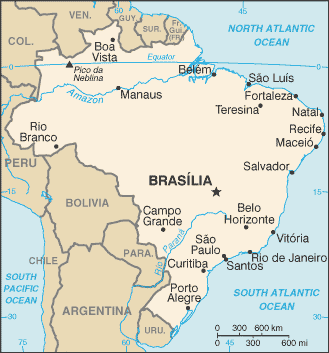Map:

Overview:
Following three centuries under the rule of Portugal, Brazil became an independent nation in 1822. By far the largest and most populous country in South America, Brazil overcame more than half a century of military intervention in the governance of the country when in 1985 the military regime peacefully ceded power to civilian rulers. Brazil continues to pursue industrial and agricultural growth and development of its interior. Exploiting vast natural resources and a large labor pool, it is today South America's leading economic power and a regional leader. Highly unequal income distribution remains a pressing problem.
The People:
Population: 186,112,794
note: Brazil took a count in August 2000, which reported a population of 169,799,170; that figure was about 3.3% lower than projections by the US Census Bureau, and is close to the implied underenumeration of 4.6% for the 1991 census; estimates for this country explicitly take into account the effects of excess mortality due to AIDS; this can result in lower life expectancy, higher infant mortality and death rates, lower population and growth rates, and changes in the distribution of population by age and sex than would otherwise be expected (July 2005 est.)
Age structure:
0-14 years: 26.1% (male 24,789,495/female 23,842,715)
15-64 years: 67.9% (male 62,669,392/female 63,719,631)
65 years and over: 6% (male 4,549,552/female 6,542,009) (2005 est.)
Religions:
Roman Catholic (nominal) 73.6%, Protestant 15.4%, Spriritualist 1.3%, Bantu/voodoo 0.3%, other 1.8%, unspecified 0.2%, none 7.4% (2000 census)
Government Type:
federative republic
Leader(s) to pray for:
chief of state: President Luiz Inacio LULA DA SILVA (since 1 January 2003); Vice President Jose ALENCAR (since 1 January 2003); note - the president is both the chief of state and head of government
Source: The World Factbook
View All Countries